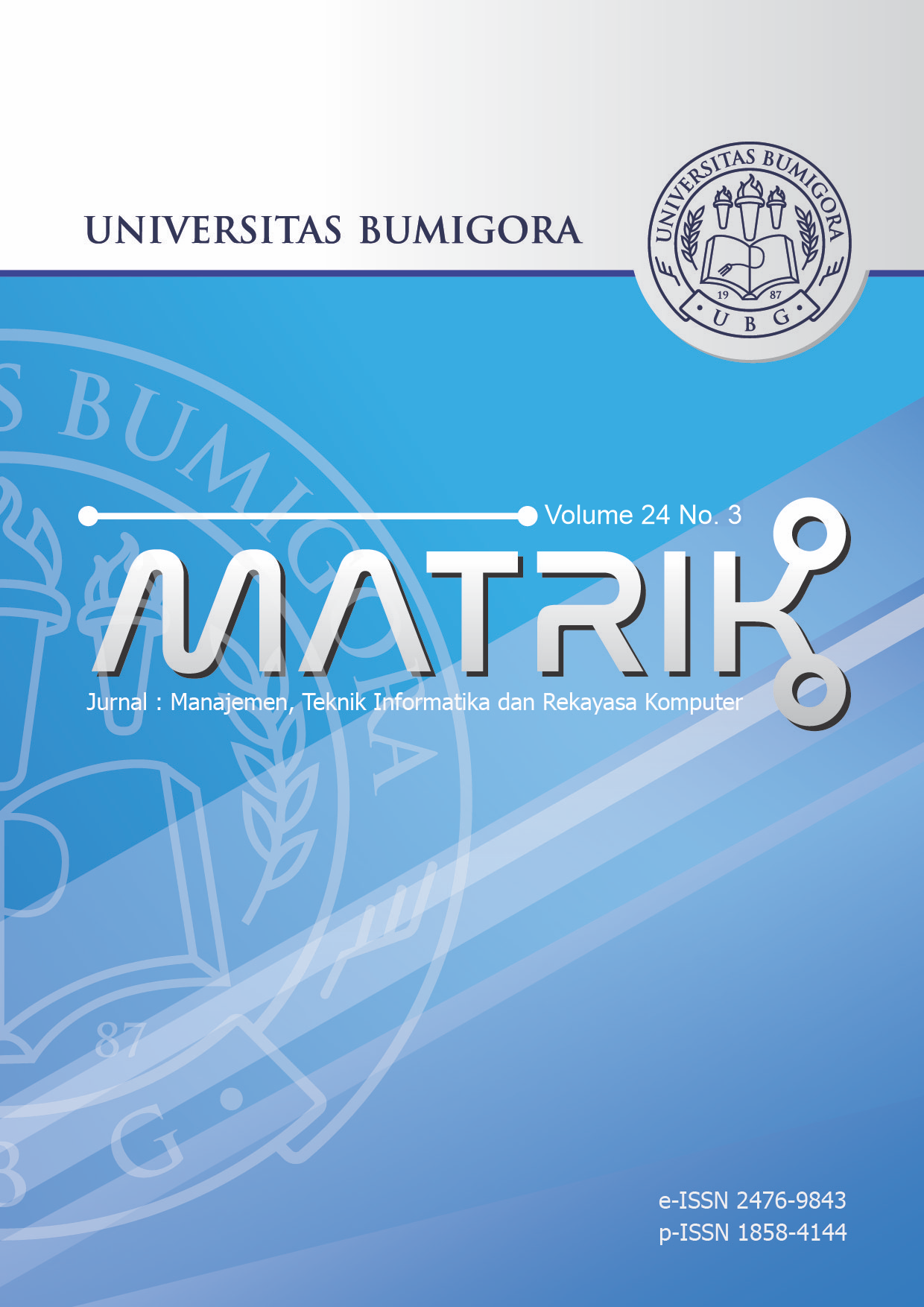A Novel CNN-Based Approach for Classification of Tomato Plant Diseases
DOI:
https://doi.org/10.30812/matrik.v24i3.4464Keywords:
Accuracy, Convolution Neural Network, Model, Performance, TomatoAbstract
Tomatoes are one of the most widely cultivated and consumed crops globally, but they are highly susceptible
to various diseases that can significantly reduce yield and quality. Early detection of these
diseases is crucial for effective management and prevention. The objective of this study is to develop
an accurate early detection system for tomato diseases using deep learning to support effective crop
management. The research method employed is a modified Convolutional Neural Network trained
on the PlantVillage dataset, which consists of 21,000 images across 10 disease classes. The study
evaluates three training scenarios using different epoch values (25, 50, and 75) to optimize model
performance. Data preprocessing included image resizing and augmentation, followed by Convolutional
Neural Network training and validation. The study’s results showed that increasing epochs
improved the model’s accuracy: 98.18% at 25 epochs, 98.53% at 50 epochs, and 99.19% at 75 epochs.
Precision, recall, and F1-score also increased, from 90.95% at 25 epochs to 95.80% at 75 epochs, indicating
enhanced model reliability. However, longer training times were required as the epoch count
increased. This research concludes that a modified Convolutional Neural Network can accurately
classify tomato diseases, providing a reliable and practical tool for early disease detection. The proposed
system has the potential to be integrated into mobile applications for real-time use in the field.
It contributes to sustainable agriculture by enabling timely disease intervention and improving crop
productivity.
Downloads
References
[1] A. Bhujel, N.-E. Kim, E. Arulmozhi, J. K. Basak, and H.-T. Kim, “A Lightweight Attention-Based Convolutional Neural
Networks for Tomato Leaf Disease Classification,” Agriculture, vol. 12, no. 2, p. 228, Feb. 2022, https://doi.org/10.3390/
agriculture12020228.
[2] Q. Wu, Y. Chen, and J. Meng, “DCGAN-Based Data Augmentation for Tomato Leaf Disease Identification,” IEEE Access,
vol. 8, pp. 98 716–98 728, 2020, https://doi.org/10.1109/ACCESS.2020.2997001.
[3] S. Ledbin Vini and P. Rathika, “TrioConvTomatoNet: A robust CNN architecture for fast and accurate tomato leaf disease
classification for real time application,” Scientia Horticulturae, vol. 330, p. 113079, Apr. 2024, https://doi.org/10.1016/j.scienta.
2024.113079.
[4] R. Wang, M. Lammers, Y. Tikunov, A. G. Bovy, G. C. Angenent, and R. A. De Maagd, “The rin, nor and Cnr spontaneous
mutations inhibit tomato fruit ripening in additive and epistatic manners,” Plant Science, vol. 294, p. 110436, May 2020,
https://doi.org/10.1016/j.plantsci.2020.110436.
[5] M. Li, G. Zhou, A. Chen, J. Yi, C. Lu, M. He, and Y. Hu, “FWDGAN-based data augmentation for tomato leaf disease
identification,” Computers and Electronics in Agriculture, vol. 194, p. 106779, Mar. 2022, https://doi.org/10.1016/j.compag.
2022.106779.
[6] J. Liu and X. Wang, “Tomato Diseases and Pests Detection Based on Improved Yolo V3 Convolutional Neural Network,”
Frontiers in Plant Science, vol. 11, p. 898, Jun. 2020, https://doi.org/10.3389/fpls.2020.00898.
[7] K. Marzuki, Apriani, and M. Qulub, “Coffee Roaster Maturity Level Classification Based on Convolutional Neural Network,”
Mathematical Modelling of Engineering Problems, vol. 12, no. 1, pp. 46–54, Jan. 2025, https://doi.org/10.18280/mmep.120106.
[8] J. Liu and X.Wang, “Early recognition of tomato gray leaf spot disease based on MobileNetv2-YOLOv3 model,” Plant Methods,
vol. 16, no. 1, p. 83, Dec. 2020, https://doi.org/10.1186/s13007-020-00624-2.
[9] S. Ahmed, M. B. Hasan, T. Ahmed, M. R. K. Sony, and M. H. Kabir, “Less is More: Lighter and Faster Deep Neural Architecture
for Tomato Leaf Disease Classification,” IEEE Access, vol. 10, pp. 68 868–68 884, 2022, https://doi.org/10.1109/ACCESS.2022.
3187203.
[10] T.-H. Nguyen, T.-N. Nguyen, and B.-V. Ngo, “A VGG-19 Model with Transfer Learning and Image Segmentation for
Classification of Tomato Leaf Disease,” AgriEngineering, vol. 4, no. 4, pp. 871–887, Oct. 2022, https://doi.org/10.3390/
agriengineering4040056.
[11] L. Tan, J. Lu, and H. Jiang, “Tomato Leaf Diseases Classification Based on Leaf Images: A Comparison between Classical
Machine Learning and Deep Learning Methods,” AgriEngineering, vol. 3, no. 3, pp. 542–558, Jul. 2021, https://doi.org/10.
3390/agriengineering3030035.
[12] M. Sholihin, M. F. M. Fudzee, and M. N. Ismail, “AlexNet-Based Feature Extraction for Cassava Classification: A Machine
Learning Approach,” Baghdad Science Journal, vol. 20, no. 6(Suppl.), p. 2624, Dec. 2023, https://doi.org/10.21123/bsj.2023.
9120.
[13] Karthik R., Hariharan M., S. Anand, P. Mathikshara, A. Johnson, and M. R., “Attention embedded residual CNN for disease
detection in tomato leaves,” Applied Soft Computing, vol. 86, p. 105933, Jan. 2020, https://doi.org/10.1016/j.asoc.2019.10593.
[14] M. Agarwal, A. Singh, S. Arjaria, A. Sinha, and S. Gupta, “ToLeD: Tomato Leaf Disease Detection using Convolution Neural
Network,” Procedia Computer Science, vol. 167, pp. 293–301, 2020, https://doi.org/10.1016/j.procs.2020.03.225.
[15] N. K. Trivedi, V. Gautam, A. Anand, H. M. Aljahdali, S. G. Villar, D. Anand, N. Goyal, and S. Kadry, “Early Detection and
Classification of Tomato Leaf Disease Using High-Performance Deep Neural Network,” Sensors, vol. 21, no. 23, p. 7987, Nov.
2021, https://doi.org/10.3390/s21237987.
[16] T. Anandhakrishnan and S. Jaisakthi, “Deep Convolutional Neural Networks for image based tomato leaf disease detection,”
Sustainable Chemistry and Pharmacy, vol. 30, p. 100793, Dec. 2022, https://doi.org/10.1016/j.scp.2022.100793.
[17] M. S. Islam, S. Sultana, F. A. Farid, M. N. Islam, M. Rashid, B. S. Bari, N. Hashim, and M. N. Husen, “Multimodal Hybrid
Deep Learning Approach to Detect Tomato Leaf Disease Using Attention Based Dilated Convolution Feature Extract
[18] A. Abbas, S. Jain, M. Gour, and S. Vankudothu, “Tomato plant disease detection using transfer learning with C-GAN synthetic
images,” Computers and Electronics in Agriculture, vol. 187, p. 106279, Aug. 2021, https://doi.org/10.1016/j.compag.2021.
106279.
[19] X. Chen, G. Zhou, A. Chen, J. Yi,W. Zhang, and Y. Hu, “Identification of tomato leaf diseases based on combination of ABCKBWTR
and B-ARNet,” Computers and Electronics in Agriculture, vol. 178, p. 105730, Nov. 2020, https://doi.org/10.1016/j.
compag.2020.105730.
[20] G. Sakkarvarthi, G. W. Sathianesan, V. S. Murugan, A. J. Reddy, P. Jayagopal, and M. Elsisi, “Detection and Classification of
Tomato Crop Disease Using Convolutional Neural Network,” Electronics, vol. 11, no. 21, p. 3618, Nov. 2022, https://doi.org/
10.3390/electronics11213618.
[21] M. Badiger and J. A. Mathew, “Tomato plant leaf disease segmentation and multiclass disease detection using hybrid optimization
enabled deep learning,” Journal of Biotechnology, vol. 374, pp. 101–113, Sep. 2023, https://doi.org/10.1016/j.jbiotec.2023.
07.011.
[22] P. Baser, J. R. Saini, and K. Kotecha, “TomConv: An Improved CNN Model for Diagnosis of Diseases in Tomato Plant Leaves,”
Procedia Computer Science, vol. 218, pp. 1825–1833, 2023, https://doi.org/10.1016/j.procs.2023.01.160.
[23] S. Yang, L. Zhang, J. Lin, T. Cernava, J. Cai, R. Pan, J. Liu, X. Wen, X. Chen, and X. Zhang, “LSGNet: A lightweight
convolutional neural network model for tomato disease identification,” Crop Protection, vol. 182, p. 106715, Aug. 2024, https:
//doi.org/10.1016/j.cropro.2024.106715.
[24] M. Melinda, Z. Muthiah, F. Arnia, E. Elizar, and M. Irhmasyah, “Image data acquisition and classification of vannamei shrimp
cultivation results based on deep learning,” MATRIK: Jurnal Manajemen, Teknik Informatika dan Rekayasa Komputer, vol. 23,
no. 3, pp. 491–508, 2024, https://doi.org/10.30812/matrik.v23i3.3850.
Downloads
Published
Issue
Section
License
Copyright (c) 2025 Miftahus Sholihin, MOHD FARHAN BIN MD. FUDZEE, Lilik Anifah

This work is licensed under a Creative Commons Attribution-ShareAlike 4.0 International License.
How to Cite
Similar Articles
- Rizky Hafizh Jatmiko, Yoga Pristyanto, Investigating The Effectiveness of Various Convolutional Neural Network Model Architectures for Skin Cancer Melanoma Classification , MATRIK : Jurnal Manajemen, Teknik Informatika dan Rekayasa Komputer: Vol. 23 No. 1 (2023)
- Tjut Awaliyah Zuraiyah, Sufiatul Maryana, Asep Kohar, Automatic Door Access Model Based on Face Recognition using Convolutional Neural Network , MATRIK : Jurnal Manajemen, Teknik Informatika dan Rekayasa Komputer: Vol. 22 No. 1 (2022)
- Evan Tanuwijaya, Angelica Roseanne, Modifikasi Arsitektur VGG16 untuk Klasifikasi Citra Digital Rempah-Rempah Indonesia , MATRIK : Jurnal Manajemen, Teknik Informatika dan Rekayasa Komputer: Vol. 21 No. 1 (2021)
- Wilda Imama Sabilla, Mamluatul Hani'ah, Ariadi Retno Tri Hayati Ririd, Astrifidha Rahma Amalia, Proliferative Diabetic Retinopathy Detection Using ConvolutionalNeural Network with Enhanced Retinal Image , MATRIK : Jurnal Manajemen, Teknik Informatika dan Rekayasa Komputer: Vol. 25 No. 1 (2025)
- Helna Wardhana, I Made Yadi Dharma, Khairan Marzuki, Ibjan Syarif Hidayatullah, Implementation of Neural Machine Translation in Translating from Indonesian to Sasak Language , MATRIK : Jurnal Manajemen, Teknik Informatika dan Rekayasa Komputer: Vol. 23 No. 2 (2024)
- Achmad Lukman, Wahju Tjahjo Saputro, Erni Seniwati, Improving Performance Convolutional Neural Networks Using Modified Pooling Function , MATRIK : Jurnal Manajemen, Teknik Informatika dan Rekayasa Komputer: Vol. 23 No. 2 (2024)
- Miftahuddin Fahmi, Anton Yudhana, Sunardi Sunardi, Image Processing Using Morphology on Support Vector Machine Classification Model for Waste Image , MATRIK : Jurnal Manajemen, Teknik Informatika dan Rekayasa Komputer: Vol. 22 No. 3 (2023)
- sayuti rahman, Marwan Ramli, Arnes Sembiring, Muhammad Zen, Rahmad B.Y Syah, Normalization Layer Enhancement in Convolutional Neural Network for Parking Space Classification , MATRIK : Jurnal Manajemen, Teknik Informatika dan Rekayasa Komputer: Vol. 23 No. 3 (2024)
- Bambang Suprihatin, Yuli Andriani, Fauziah Nuraini Kurdi, Anita Desiani, Ibra Giovani Dwi Putra, Muhammad Akmal Shidqi, Lungs X-Ray Image Segmentation and Classification of Lung Disease using Convolutional Neural Network Architectures , MATRIK : Jurnal Manajemen, Teknik Informatika dan Rekayasa Komputer: Vol. 23 No. 1 (2023)
- Fitra Ahya Mubarok, Mohammad Reza Faisal, Dwi Kartini, Dodon Turianto Nugrahadi, Triando Hamonangan Saragih, Gender Classification of Twitter Users Using Convolutional Neural Network , MATRIK : Jurnal Manajemen, Teknik Informatika dan Rekayasa Komputer: Vol. 23 No. 1 (2023)
You may also start an advanced similarity search for this article.


.png)












